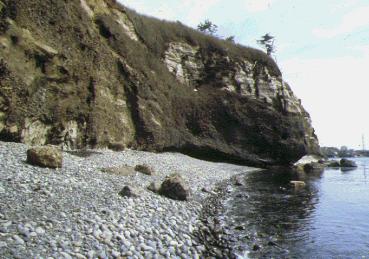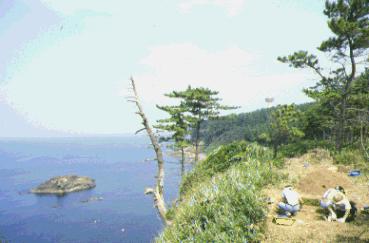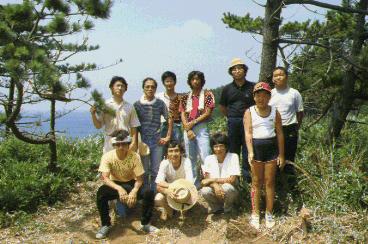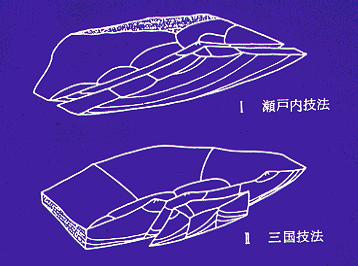Mikuni Technique: a Side-blow
Technique
in the Upper Paleolithic Industries
Nishi-shimomukai Site is located at the hamlet of Komegawaki,
Mikuni, Fukui Prefecture, Central Japan. In 1967, a pyroxene andesite artifact
has been collected at one of the cuttings on a promenade running along
precipitous beach. It is in 1981, that this find is identified as a "Koh
Knife", one of the key-artifacts in Upper Palaeolithic in Japan, which
lead to the subsequent excavation in 1982 and 1983.
The flaking technique conceived of the component has common features with
the Setouchi Technique, which is characteristic to the Upper Palaeolithic
industries in Western Japan: the dorsal surface of a massive flake is applied
for the striking platform of a core; then a side-blow (commonly referred
as "wing-shaped") flake is knocked off from either end; to retain
distal region of such flat core on the dorsal surface of the flake. Closer
examination of the Nishi-shimomukai specimens, however, proves of some
distinctiveness. The striking points, disclosed on the cores, show wavy
shift along a zig-zag line, whereas those of Setouchi Technique show draw-back
along a straight line. In the consequence, proximal view of the flakes
is not so "wing-shaped" as typical flakes of Setouchi Technique.
To the author's view, these distinctiveness seem provide a sufficient basis
to ascribe the Nishi-shimomukai component to a distinct technique, to be
termed as Mikuni Technique.
Publications
- Hiraguchi,T. et al., 1983, Nishi-shimomukai Site: Preliminary Report
of the First and Second Excavation, Mikuni-machi Board of Education, Japan.
(In Japanese with English summary)
- Hiraguchi, T. et al., 1984, A Side-blow technique of the Paleolithic
industries at the Nishi-shimomukai, Central Japan. Paleolithic Archaeology,
28: 5-18. (In Japanese)
- Hiraguchi, T., 1987・88・89, Types of the Side-blow Technique, Taiheidai-shiso,
6:1-12・7:1-18・8:45-63. (In Japanese)
- Hiraguchi, T., 1994, Definitions of 'Setouchi technique from the viewpoint
of terminology and quantitative analysis, Setouchi Technique and the
Age, 83-90. (In Japanese)
Photographs
A view of Nishi-shimomukai Site from the Southwest,
1982.
 |
A snapshot of the third excavation,
1983.
 |
A souvenir photograph of the third excavation,
1983.
 |
Uper: Setouchi Technique
Lower: Mikuni Technique.
 |




